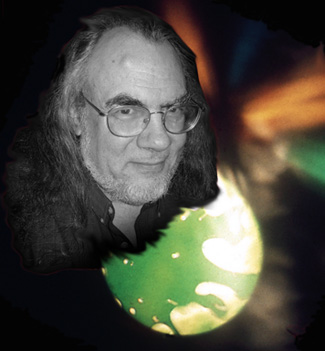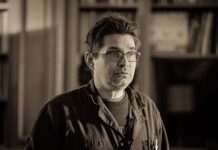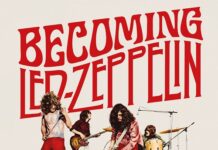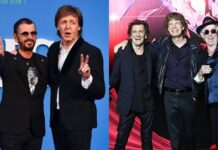By Ralph Greco, Jr.
Marc L. Rubinstein is a musician turned pioneer in liquid and psychedelic light shows of the mid 60s and early 70s. Rubinstein’s Pig Light Show at the Fillmore East set standards for what is now regarded an essential part of any concert — eye-catching visual eye candy to go with the performers on stage. Now, The Pig Light Show is back until December, 31 2011 at Bethel Woods Center for the Arts, site of the 1969 Woodstock Music & Art Fair. The exhibit features full-length light show creations as well as a documentary on the history of Pig Light Show.
Born in Chicago and on a plane to New York four days later (at that time, the youngest passenger ever to fly Eastern Airlines), Rubinstein grew up in Long Beach, New York, playing music in the same bars and clubs as such luminaries as Leslie West and the Vagrants, Billy Joel and the Hassles and Vanilla Fudge.
With his Pig Light Show, Rubinstein was one of the innovators behind the early liquid and psychedelic light shows on the East Coast. Amazing concert goers at the Fillmore East in New York and the Capitol Theatre in New Jersey (and many other spots) in the 60s and 70s, Rubinstein, aka Pig, played his unusual colors behind and on legendary music artists like the Grateful Dead, Jethro Tull, Santana, Yes, Black Sabbath and Fleetwood Mac.
The Pig Light Show’s visuals were like nothing ever seen before or since. Mark Hudson, producer for Ozzy Osbourne and Aerosmith, once exclaimed: “I don’t need drugs…all I have to do is watch Pig Light Show and I’m as high as I want to be!”
Working, learning, and eventually given a blessing from the infamous Joshua from Joshua Light Show, Pig was on his way, doing his own thing, playing parties, clubs and concerts (he was actually given his nickname by Frank Zappa) and taking the name Pig Light Show over St. Elmo’s Fire. An East Coast legend was born. I had the pleasure of sitting down with Rubinstein for his take on his interesting career and what he’s doing with it presently.
~
Let’s start with your impression of the West Coast vs. East Coast in regard to concerts when you first got into the scene. Was there battle-lines drawn or a healthy competition?
Each had their own sounds, their own styles; I don’t remember any air of competition at all. Everybody was into everybody else and interested in what was coming next. On the West Coast there were all these Be Ins and Trips Festivals and a lot more outdoor concerts and such. So then the clubs which became big concert venues had the same open, free form feeling. The Family Dog, The Avalon Ballroom and the original Fillmore were big dance halls. The light shows on the West Coast were mostly formed by visual artists experimenting with light as a new medium and as part of the drug scene swiftly growing. There was a lot of interest in recreating the effects and feeling of acid trips.
The East Coast scene was much more theatrical, with the models being things like the Murray the K shows with a lot of bands playing few songs. There were seats and seating in that mindset, as well as the ambiance of The Peppermint Lounge, Steve Paul’s Scene and other “discotheques” (nothing to do with the later scourge known as Disco). New York especially was full of promoters who used theaters as concert halls.
And before you there was the Joshua Light Show, right? I mean Pig grew from that group, correct?
Yes we had Joshua as the hallmark. Joshua had befriended Glen McKay of West Coast Headlights fame (they toured with the Jefferson Airplane among others and was the light show seen in Monterey Pop), but Joshua was trained in theater and film. He understood the fact that when the audience can see the light show people at work the results were much less mystical, less impressive…less theatrical. He chose to almost exclusively do rear projection and at concerts.
Pig light show was a bit different in that besides being into lighting, I was a musician. I loved the theatrical nature of New York shows and Joshua’s approach and when I started doing light shows figured most things out for myself. After meeting Joshua (I wrote to him at The Fillmore East and he invited me backstage one night) I got encouragement, but he avoided letting me get away without the trial and error. He once said, “Remember your mistakes, they may be the most creative things you ever come up with.” It was true. But I think the musician in me was what kept Pig Light Show unique. I always looked at what I do as part of the musician’s performance, jamming light with them. I wasn’t just adding my art to theirs behind them, every beat, theme, movement of the music was a part of the light show.
As shows got bigger and better, how did you retain and maintain the unique work only you did?
Well, there was a point when concerts quickly went from great, more intimate venues like The Fillmore East, John Scher’s Capitol Theatre in Passaic, Howard Stein’s Capitol in Portchester (and then The Academy Theatre), The Ritz and other places to Madison Square Garden and arena venues. Bands, promoters, management agencies, record companies all saw big and quick money and abandoned small venues for large. The 70s brought the Buck as prime motivation for music. Concerts changed, lighting changed, audience expectations changed and light shows were forgotten for many, but largely monetary, concerns. I went into education and taught stage lighting and kept the light show alive through occasional local shows at medium sized venues and demos at various schools and such.
Can you tell me of one of the better shows you were part of, say one from each coast, two different bands maybe?
Oh, wow. There were so many, as well as the British groups. I’d say my favorite West Coast band to perform with may have been Santana, but Hot Tuna and the Dead were fun too. A couple of years ago I did a show with The Electric Prunes and that was a ball. East Coast band? Probably Mountain, Vanilla Fudge or Cactus. They were all bar bands on Long Island as we all grew into the business, and it was sort of like coming home when I worked with them.
Who was your favorite band you worked with and why?
Depends on how I’m feeling any given day. One of the most fun was Phantasmagoria out of Staten Island who backed up Geoffrey Crozier, an Australian magician who was part Houdini, part Arthur Brown and a bit of Alice Cooper. It was just fun, and I was doing lighting not even a light show, but it was so cool. I did Carnegie Hall with them.
In the face of ever-changing technologies and how different the concert business is now, how do you take an ‘older’ style and incorporate it into the modern day scene?
The basic thing is, I do the effects live in my studio and video record them. These cannot be bought from any VJ company or anywhere else. I create some effects directly on my Mac and often combine the old school light show footage with them or tweak the footage with digital filters. This all results in a “feel” of the original with a very modern edge; it’s very satisfying, actually. So the art is in the initial creation of the effects as well as how I use them in the live shows or videos. And the musician in me makes it all work in the performance. The video clips are my riffs, the control surface my instrument, the video projector my amplifier. I literally “play” with the band, and if they trust me, it never goes wrong.
What’s coming up in the future for you?
Well, I wish I could list a thousand things, but the economy and the state of the industry is against me. It’s been a lot of trying to educate people as to why they should use a light show. So many call the stage lighting a light show and have no idea how far off the mark they are. Education is slow, and there is still that attitude wherein a promoter will spend a mint on true non-essentials but claim a light show is too expensive. And when they do use “light show” or video effects, as opposed to using video to help the audience see the bands in a huge venue (which was pioneered by Joshua with his Joshua Television, by the way), they do it cheaply or plain wrong. My ex boss from the Capitol Theatre days, John Scher told me a story which illustrates my problem well. When he saw the Cream Reunion concert at Madison Square Garden, he said he could instantly tell the general age of anybody in the audience after the show, because if they said the “light show” Cream had was cool they were too young to have seen a real one like Joshua or Pig. The younger the audience, the more blown away they are, and especially when they find out these are not computer-generated effects. As far as the future, who knows…
For more information, visit the official Pig Light Show website.




















